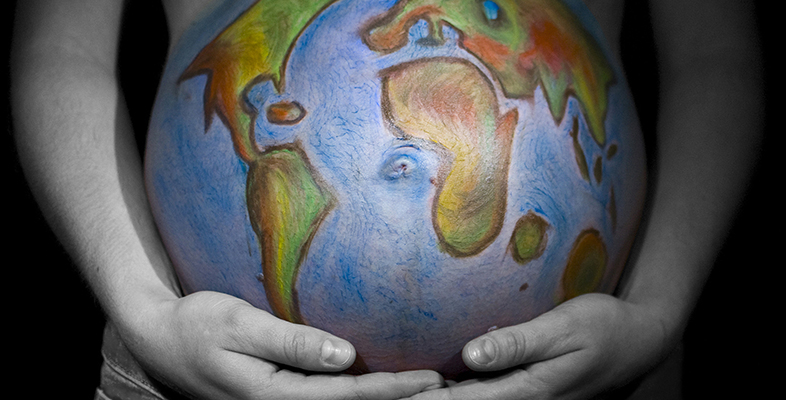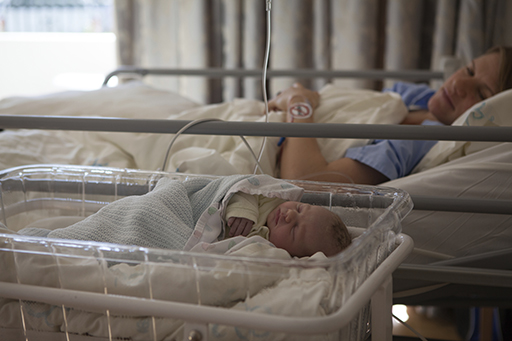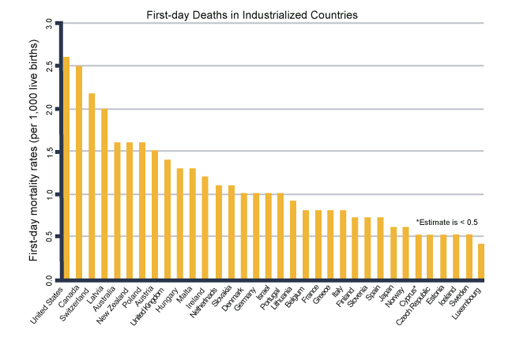2.2 State of the world’s mothers
Today, much of infant mortality is preventable. However, while you may or may not have been surprised by some of the maternal and infant mortality figures you have just read, there are some interesting anomalies worldwide.
The USA, for example, has a surprisingly high number of babies dying on the first day of life. The Save the Children report, ‘State of the World’s Mothers 2013’, from which you will read an extract of next, shows how even in such highly developed Western countries such as the USA there are still issues to be dealt with.
Extract _unit3.3.2 Saving newborn lives in industrialized countries
While only 1 percent of the world’s newborn deaths occur in industrialized countries, the newborn period is still the riskiest time, no matter where a baby is born. The percentage of infant deaths that occur during the newborn period is rising in wealthy countries, as it is in poor countries. Almost everywhere, the day of birth is the riskiest time for newborns. Some causes of newborn deaths in wealthy countries are similar to those in developing countries, especially those related to preterm birth. But many common killers of newborns in developing countries – such as birth complications and infections – almost never cause babies to die in rich countries.
The United States has the highest first-day death rate in the industrialized world. An estimated 11,300 newborn babies die each year in the United States on the day they are born. This is 50 percent more first-day deaths than all other industrialized countries combined. The 33 other industrialized countries for which there are data have a combined total of 7,500 first-day deaths each year.
The large U.S. population size explains some of this disparity, but it does not explain all of it. The U.S. represents 31 percent of the population in these 34 industrialized countries and 38 percent of the annual live births, but it has 60 percent of all first-day deaths. When first-day deaths in the United States are compared to those in the 27 countries making up the European Union, the findings show that European Union countries, taken together, have 1 million more births each year (4.3 million vs. 5.3 million, respectively), but only about half as many first-day deaths as the United States (11,300 in the U.S. vs. 5,800 in EU member countries).
Canada and Switzerland have the second and third highest first-day death rates in the industrialized world, respectively. Switzerland has the highest share of newborn deaths that are first-day deaths found anywhere in the world: 71 percent of Swiss babies who die in their first month die on their first day.
Newborns in these three countries – the United States, Canada and Switzerland – are at least 4 times as likely to die on the day they are born as babies born in the lowest-mortality countries where first-day death rates are at or below 0.5 per 1,000 live births.
Across these industrialized countries, first-day deaths account for 30 percent of under-5 mortality. In Australia, Austria, Canada and the United States, the share is higher – more than 1 in 3 deaths to children under age 5 are to newborns on their first day of life. In Switzerland, it’s closer to 1 in 2 (48 percent).
Why does the United States have so many first-day deaths?
Many babies in the United States are born too early. The U.S. preterm birth rate (1 in 8 births) is one of the highest in the industrialized world (second only to Cyprus). In fact, 130 countries from all across the world have lower preterm birth rates than the United States. The U.S. prematurity rate is twice that of Finland, Japan, Norway and Sweden. The United States has over half a million preterm births each year – the sixth largest number in the world (after India, China, Nigeria, Pakistan and Indonesia).
According to the latest estimates, complications of preterm birth are the direct cause of 35 percent of all newborn deaths in the U.S., making preterm birth the number one killer of newborns. Preterm birth is a major cause of death in most industrialized countries and is responsible for up to two-thirds of all newborn deaths in countries such as Iceland and Greece.
The United States also has the highest adolescent birth rate of any industrialized country. Teenage mothers in the U.S. tend to be poorer, less educated, and receive less prenatal care than older mothers. Because of these challenges, babies born to teen mothers are more likely to be low-birthweight and be born prematurely and to die in their first month. They are also more likely to suffer chronic medical conditions, do poorly in school, and give birth during their teen years (continuing the cycle of teen pregnancy).
Poverty, racism and stress are likely to be important contributing factors to first-day deaths in the United States and other industrialized countries. Current data do not allow for analysis of first-day death rates among disadvantaged groups in wealthy countries, but newborn and infant mortality are often higher among the poor and racial and ethnic minorities, and populations with high newborn mortality rates also tend to have high first-day death rates. Poor and minority groups also suffer higher burdens of prematurity and low birthweight which likely lead to first-day deaths in the U.S. and elsewhere. One recent analysis of U.S. data found that most of the higher infant mortality experienced by black and Puerto Rican infants compared with white infants was due to preterm-related causes. These groups are also less likely to receive the high-risk care they need, which puts their babies at even higher risk.
So, even in a wealthy and industrialised country such as the USA, where wide disparities of income, wealth, health and education exist, they are reflected in things such as high mortality rates among young children. Disadvantaged groups experience a greater number of pre-term births, low birth weight babies and births to teenage mothers. This, along with unequal access to medical care, leads to poor outcomes.
However, countries like the USA do actually possess social services and educational institutions and their hospital and community health services can respond to these problems.


